With its jaw-dropping Colorado views, cliff-hanging corners and stunning 14,100-foot finish line, there's little doubt as to why the Pikes Peak International Hill Climb is touted as an event that every racer should try at least once. Having competed in the exhibition class at Pikes Peak in 2007 aboard a CRF150R(Mini Rider, November '07), I was interested in hitting the mountain for a second time, though I found last year's race a bit...well, ceremonious. As fate would have it, I got my chance to do it again when a surprise entry opened up in the 250cc class, allowing me to drive straight from the Las Vegas EnduroCross to the foot of the mountain with little time to spare. Upon arrival in Colorado Springs, I was greeted by the usual display of pomp and pageantry that I had learned to expect at the race. But a bad experience with a particularly pompous, freestyler-hating race promoter threw my outlook into "half-empty" mode, and I suddenly began to look at the race with a whole new set of eyes. Throughout the following week, the cynic in me took to analyzing the various points of the event and decoding them from fable to fact. Being the compulsive journalist that I am, I even made a list of what I saw and cataloged the various points into the top misapprehensions and their respective realities. So without further ado, here's what I feel to be the real scoop on the illustrious "Race to the Clouds."Pre-Registration
Fable: According to the race organizers, the first step that a racer must take in conquering Pikes Peak is to fill out all the necessary registration paperwork. The process is simple, and all forms are available to fill out online.
Fact: I could probably buy a belt-fed machine gun without completing half as much paperwork as is required for Pikes Peak. Do they seriously need to know the address and phone number of where my bike will be staying during race week? Is that so we can call it if it sleeps in? And since when do you need a physical examination to race a motorcycle? Luckily, DR's own Dr. Tarlow put me through the express line at his office, but even then I refused to have blood drawn just so I could ride. Thus, the answer box on my entry form coinciding with blood type simply read N/A-which, as we all know, stands for "Needles/afraid."Tech Inspection
Fable: The PPIHC staff must complete a thorough, mandatory inspection of each race vehicle to make sure that it meets current safety standards and is suitable for high-altitude competition.
Fact: Either the tech guys don't like dirt bikes or they just didn't like me. Despite the fact that my bike had a brand-new air filter, clutch, brake pads, hand guards, levers, tires and jetting, I failed tech inspection and was told that my bike was unsuitable for competition because the plastic was "absolutely filthy." Excuse me, but is this a beauty pageant or a motorcycle race? Luckily, I passed tech the next morning with the help of some good ole spray polish, but that still didn't save me from the solid chewing-out I received from the event referee concerning my tire choice. Since when is a Dunlop 745 not DOT-approved?Practice
Fable: Practice at the mountain is a snap. Each of the three practice days are run promptly at first light, allowing competitors up to three hours to learn the course, pick out lines and tune their machines.
Fact: When you have to be on the bike at 5:30 a.m. sharp, waking up at 3:15 a.m. is considered oversleeping. Pikes Peak is as much an exercise in sleep deprivation as it's in riding skill, and the racers, mechanics and race organizers are so darn moody come race day you'd think there was pure estrogen seeping out of the mountain.Classes
Fable: The motorcycle portion of Pikes Peak is divided into several divisions. From 450cc supermoto bikes to custom sidecars and decked-out quads, all are welcome. There's even a 1200cc division for the really big bike riders, as well as a vintage class for those who still enjoy the classics.
Fact: Although all the motorcycle racers are split up into the aforementioned classes, everybody runs practice at the same time. Now, I'm not much for whining about getting passed or even roosted by another rider, but I will say that when I almost got run off the course by the visor-less Banshee pilot with a fused right thumb and "that crazy look" in his eyes, I truly feared for my life.Tuning
Fable: With the help of some quick jetting changes and a little advice from the many veterans of the event, it's easy to tune your bike to handle the rigors of extra high-altitude racing.
Fact: At 14,100 feet above sea level, nothing runs well. In fact, the common off-road bike will likely run like it has a dirty sock in the airboot. However, the trick isn't in getting it to run properly, but to keep it running without completely destroying the motor. Oh fuel injection, where art thou?
Course
Fable: Covering 12.42 miles with over 4700 feet of elevation gain, the gravel/asphalt course up Pikes Peak is a uniquely majestic place to ride a motorcycle and is easily memorized in practice.
Fact: Of the 156 total turns that make up the racecourse, it seems that the only corner I could consistently remember was the one after the turn where I almost rode straight off the edge of the mountain. Fellow Colorado native and AA Enduro rider Bryan Penney wasn't quite as lucky; poor Bryan mobbed his Aprilia 450 off a surprise edge and into oblivion, decimating his bike in the process and reminding everyone just how high these turns really are.Talent
Fable: When it comes to watching their heroes ride, Pikes Peak fans are always in for a treat. Micky Dymond, Davey Durelle, Joe Kopp, Cristan Lancellotti, Greg Tracy and Gary Trachy were in attendance this year, joined by industry staples Paul Thede (founder of Race Tech), Scott Forward (founder of Scotts Performance), Alexander Smith (son of Malcolm Smith) and Scott Hoffman (editor of SuperMoto Racer Magazine). Even former Honda racer and Baja 1000 winner Mike Childress showed up to try his luck up the mountain, this time with a modified Ford F-150 in the Pro Truck class. All were ready to dazzle the spectators with their skills.
Fact: Due to the one-shot format and high-speed nature of the race, fans rarely have a clue who anyone is. Even if you're standing at the end of a long straightaway, a bike can blow past you and be halfway around the next corner faster than you can yell, "Go, Micky!" No doubt, it's fun to watch the hero riders at Pikes Peak, but it'd be twice as much fun to watch them race up more than once!Cars
Fable: Despite the strong motorcycle presence, Pikes Peak is and always will be a car race. First run in 1916, the auto portion of the event brings out a downright radical assemblage of open wheel, vintage, pro stock and truck competitors. Each of the car divisions is extremely competitive.
Fact: Although nearly half of the course is paved with asphalt, Pikes Peak isn't exactly an auto racer's dream. This year, I saw more crashed, ditch-ridden cars in one trip up the mountain than I'd see in a month on California's I-5 freeway (and that's saying a lot). No kidding, I even saw a rally car in a tree not one mile from the starting line! The race was red-flagged a record number of times, but even worse was that a few of the crashes were pretty serious for the drivers. Safety first, people...Racing
Fable: The Pikes Peak race format is flawless. After a timed qualifying session earlier in the week determines starting order, racers leave the line in waves for their own assault up the mountain. Each class is followed by a short break, giving the racers time to make their runs before the next batch of riders is sent up.
Fact: Seeing as you only get one timed run up the mountain, it's essential to make that run as perfect as possible. While the system certainly is fair, something as small as a fouled spark plug or broken clutch lever can ruin your race, effectively nullifying the previous five days and hundreds of dollars that you've invested in the race. To a well-rested racer this may seem like the luck of the draw, but to a sleep-deprived human, a broken master link or frayed cable could easily lead to utter disappointment and a torrent of tears. And nobody likes to see a grown man cry.Sportsmanship
Fable: Most Pikes Peak competitors are there exclusively for a fun time. Numerous high-fives, congratulations and kind words surround the finish line at the top. Here, everyone congregates to bench race and shake hands until the completion of the event when the course is opened to come back down.
Fact: Notice that I said "most" racers come to Pikes Peak to have fun. Apparently, some also come to punch people in the face. In my class, first-place finisher Mark Miller battled his way to the lead and was ecstatic to learn that he'd set a new course record in the process. However, his enthusiasm was mildly soured when the second-place guy came up and socked old Mark right in the mouth. Apparently, the battle for first got a bit heated at times, and Mr. Runner-up just didn't like that. I never thought I'd say this, but I'm sure glad I didn't win the race!The Verdict...Fact Or Fable?
Now in its 86th year running, the Pikes Peak International Hill Climb certainly is a momentous event. The race may entertain a pompous atmosphere that's hopelessly easy to make fun of, but any kind of motorized event this old demands respect. Whether you're attracted by the fables or put off by the facts on my list, I'd suggest that you at least check out the event once to see what it's all about. If hard-core off-road is your thing and you haven't the patience to go along with the pageantry, you might find that Pikes Peak isn't your quart of oil. But if you're a laid-back, rule-following road rider with an intimate knowledge of high-altitude jetting and a penchant for delivering knuckle sandwiches immediately following a race, this event just might be right up your alley. Me? I'm somewhere in the middle.


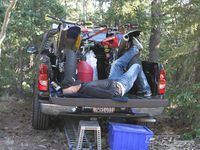

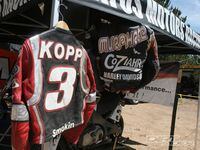





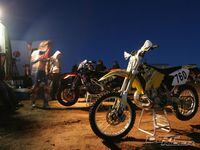

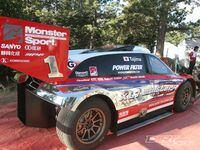


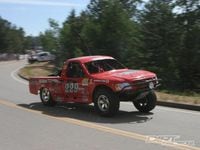
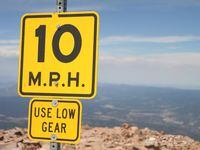
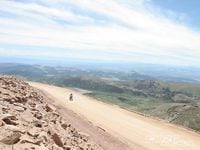
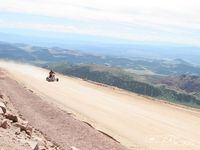
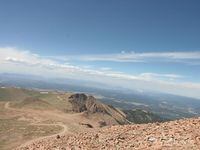

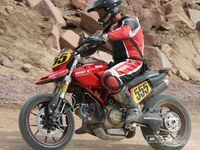

/cloudfront-us-east-1.images.arcpublishing.com/octane/XTROSHDZFJB5DIJYU2VF2REFIU.jpg)
/cloudfront-us-east-1.images.arcpublishing.com/octane/5A776WXBY5GAPDYFTTUEUZNIJA.jpg)
/cloudfront-us-east-1.images.arcpublishing.com/octane/NCYHFQ2S3BAT7EC7VDN2ONGRTU.jpg)
/cloudfront-us-east-1.images.arcpublishing.com/octane/XQORS527YFFT3MVI326EOEYJUI.jpg)
/cloudfront-us-east-1.images.arcpublishing.com/octane/TVDPP3TGMZHODFXASIFUM2KD34.jpg)
/cloudfront-us-east-1.images.arcpublishing.com/octane/EWDMR3DDTBBQPI7DQVZCLMRFAE.jpg)
/cloudfront-us-east-1.images.arcpublishing.com/octane/4XHHLVOUKFE3PDSWNSV4JJMGOE.jpg)
/cloudfront-us-east-1.images.arcpublishing.com/octane/5RLI3NQKQJA3LKKCQHRXQFTL6Q.jpg)
/cloudfront-us-east-1.images.arcpublishing.com/octane/3QCYJCI2RNBENIRWAKEOEKHFUM.jpg)
/cloudfront-us-east-1.images.arcpublishing.com/octane/UZHF7KAE7BFN7KU734ER7PPP3Q.jpg)
/cloudfront-us-east-1.images.arcpublishing.com/octane/XJFFFMRN6VEZ7CDNAGKWVPC3H4.jpg)
/cloudfront-us-east-1.images.arcpublishing.com/octane/RMC3CHWSHFAUJA2WJ2FVG4NBOA.jpg)
/cloudfront-us-east-1.images.arcpublishing.com/octane/WXEZV4WAYBERFKSRE5M7GQBW7A.jpg)
/cloudfront-us-east-1.images.arcpublishing.com/octane/LO3PZVGICFGJZBNUA2ORUSAUSE.jpg)
/cloudfront-us-east-1.images.arcpublishing.com/octane/UFHLTNOXLVARVLZV32M6ZJZV4Y.jpg)
/cloudfront-us-east-1.images.arcpublishing.com/octane/CTSWNU7SNNCC3LWB2KATYZ5AXY.jpg)
/cloudfront-us-east-1.images.arcpublishing.com/octane/IBNGAQWHJJF4TKSIQT54MTWRYQ.jpg)
/cloudfront-us-east-1.images.arcpublishing.com/octane/EAEWHFARGVGHFH4N4BDOSNBJSU.jpg)
/cloudfront-us-east-1.images.arcpublishing.com/octane/AZ7H35TQSZDKZCVM4S6CHERQEU.jpg)
/cloudfront-us-east-1.images.arcpublishing.com/octane/GYMIU7SMN5CWHP6QLFR6MVKEBU.jpg)
/cloudfront-us-east-1.images.arcpublishing.com/octane/B3CX7C4BFFCKBLDWHPQFACBH2E.jpg)
/cloudfront-us-east-1.images.arcpublishing.com/octane/6EIBG7NN4BH4FKDBCPCTLQL6FU.jpg)
/cloudfront-us-east-1.images.arcpublishing.com/octane/3RBI4ZG5NNBCTEUK7MWMKVZ5BE.jpg)
/cloudfront-us-east-1.images.arcpublishing.com/octane/3QKLYI2BWVAMRNNFC5KCGUYRAU.jpg)